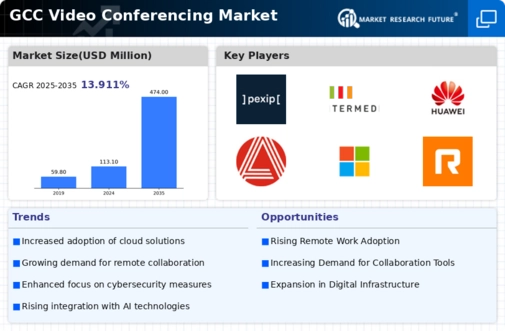The video conferencing market is currently characterized by a dynamic competitive landscape, driven by rapid technological advancements and an increasing demand for remote collaboration solutions. Major players such as Zoom Video Communications (US), Microsoft (US), and Cisco Systems (US) are at the forefront, each adopting distinct strategies to enhance their market positioning. Zoom Video Communications (US) has focused on expanding its product offerings and enhancing user experience through continuous innovation, while Microsoft (US) leverages its existing ecosystem to integrate video conferencing capabilities into its suite of productivity tools. Cisco Systems (US), on the other hand, emphasizes security and reliability, catering to enterprise clients with robust solutions that ensure data protection and seamless communication. Collectively, these strategies contribute to a competitive environment that is increasingly centered around user-centric innovations and integrated solutions.
In terms of business tactics, companies are increasingly localizing their operations and optimizing supply chains to better serve regional markets. The competitive structure of the market appears moderately fragmented, with several key players vying for market share while also facing competition from emerging startups. This fragmentation allows for diverse offerings, yet the influence of established players remains significant, shaping customer expectations and driving innovation across the sector.
In October 2025, Zoom Video Communications (US) announced a strategic partnership with a leading AI firm to enhance its video conferencing platform with advanced AI-driven features. This move is likely to bolster Zoom's competitive edge by providing users with intelligent meeting insights and automated transcription services, thereby improving overall user engagement and satisfaction. Such innovations may position Zoom favorably against competitors who are also investing in AI capabilities.
In September 2025, Microsoft (US) unveiled a new feature within its Teams platform that integrates real-time translation capabilities, aimed at facilitating global collaboration. This strategic enhancement not only broadens the appeal of Microsoft Teams but also aligns with the growing trend of remote work and international business operations. By addressing language barriers, Microsoft is likely to attract a more diverse user base, further solidifying its market presence.
In August 2025, Cisco Systems (US) launched a new security framework specifically designed for its video conferencing solutions, addressing increasing concerns over data privacy and security breaches. This initiative underscores Cisco's commitment to providing secure communication tools, which is particularly appealing to enterprise clients. By prioritizing security, Cisco may differentiate itself in a market where trust and reliability are paramount.
As of November 2025, current trends in the video conferencing market include a strong emphasis on digitalization, sustainability, and the integration of AI technologies. Strategic alliances are increasingly shaping the competitive landscape, as companies seek to combine strengths and resources to deliver comprehensive solutions. Looking ahead, it appears that competitive differentiation will evolve from traditional price-based competition to a focus on innovation, technological advancements, and supply chain reliability. This shift may redefine how companies position themselves in the market, emphasizing the importance of delivering unique value propositions that resonate with evolving customer needs.

















Leave a Comment